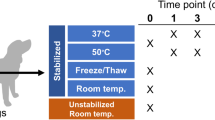Abstract
All animals need clean water to drink. At the authors' animal facility, drinking water for immunocompromised rodents is filtered by reverse osmosis, acidified during bottling and sterilized in an autoclave. Autoclaved water bottles can be stored in unopened autoclave bags for 7 d or in opened bags for 2 d; if not used during that time, they are emptied, cleaned, refilled and sterilized again. The authors wished to determine whether the storage period of 2–7 d was adequate and necessary to ensure the quality of drinking water. They tested water bottles for pH levels and for the presence of adenosine triphosphate as a measure of organic contamination during short-term and long-term storage. The pH of autoclaved drinking water generally remained stable during storage. Furthermore, no instances of organic contamination were detected in autoclaved water bottles stored for up to 22 d in unopened bags and only one instance was detected in bottles stored for up to 119 d in opened bags in a room with individually ventilated cages. On the basis of these findings, the acceptable storage period for autoclaved water bottles in opened bags at the authors' facility was extended to 21 d.
This is a preview of subscription content, access via your institution
Access options
Subscribe to this journal
We are sorry, but there is no personal subscription option available for your country.
Buy this article
- Purchase on Springer Link
- Instant access to full article PDF
Prices may be subject to local taxes which are calculated during checkout


Similar content being viewed by others
References
Institute for Laboratory Animal Research. Guide for the Care and Use of Laboratory Animals 8th edn. (National Academies Press, Washington, DC, 2011).
2011 Drinking Water Report Indianapolis & Morgan Co. (Citizens Water, Indianapolis, IN, 2011).
Pseudomonas aeruginosa—Technical Sheet (Charles River, Wilmington, MA, 2009).
Hessler, J.R. & Hoglund, U. Laboratory animal facilities and equipment for conventional, barrier, and containment housing systems in Handbook of Laboratory Animal Science 2nd edn. (eds. Hau, J. & Van Hoosier Jr., G.L.) (CRC Press, Washington, DC, 2003).
Nunamaker, E.A., Otto, K.J., Artwohl, J.E. & Fortman, J.D. Leaching of heavy metals from water bottle components into the drinking water of rodents. J. Am. Assoc. Lab. Anim. Sci. 52, 22–27 (2013).
Gordon, A. & Wyatt, J. The water delivery system affects the rate of weight gain in C57BL/6J mice during the first week after weaning. J. Am. Assoc. Lab. Anim. Sci. 50, 37–40 (2011).
Tobin, G., Stevens, K.A. & Russell, R.J. Nutrition in The Mouse in Biomedical Research (eds. Fox, J.G. et al.) (Elsevier, Amsterdam/New York, 2007).
Thibert, P. Control of microbial contamination in the use of laboratory rodents. Lab. Anim. Sci. 30, 339–351 (1980).
Drinking Water Acidification (Edstrom Industries, Waterford, WI, 2003).
National Research Council. Rodents that require special consideration in Laboratory Animal Management: Rodents (National Academies Press, Washington, DC, 1996).
Edstrom, E.K. & Curran, R. Quality assurance of animal watering systems. Lab Anim. (NY) 32, 32–35 (2003).
Turner, D.E., Daugherity, E.K., Altier, C. & Maurer, K.J. Efficacy and limitations of an ATP-based monitoring system. J. Am. Assoc. Lab. Anim. Sci. 49, 190–195 (2010).
Carter, G.R. & Wise, D.J. Staphylococcus in Essentials of Veterinary Bacteriology and Mycology (Blackwell Publishing, Ames, IA, 2004).
Ednie, D.L., Wilson, R.P. & Lang, C.M. Comparison of two sanitation monitoring methods in an animal research facility. J. Am. Assoc. Lab. Anim. Sci. 37, 71–74 (1998).
Acknowledgements
We thank our cage wash and husbandry staff, without whom this work would not have been possible, especially Angie Bohall, RLATg, Suz Hewitt, RALAT, Mark Galovic and Cindy Wooldridge, RLATg. We thank Melissa Swan, RVT, AAS, RALAT, for help with the microbiology plan. We also thank Dr. John Turchi, PhD for access to his lab and use of his Accumet pH meter.
Author information
Authors and Affiliations
Corresponding author
Ethics declarations
Competing interests
The authors declare no competing financial interests.
Rights and permissions
About this article
Cite this article
Peveler, J., Crisler, R. & Hickman, D. Quality testing of autoclaved rodent drinking water during short-term and long-term storage. Lab Anim 44, 211–215 (2015). https://doi.org/10.1038/laban.734
Received:
Accepted:
Published:
Issue Date:
DOI: https://doi.org/10.1038/laban.734



